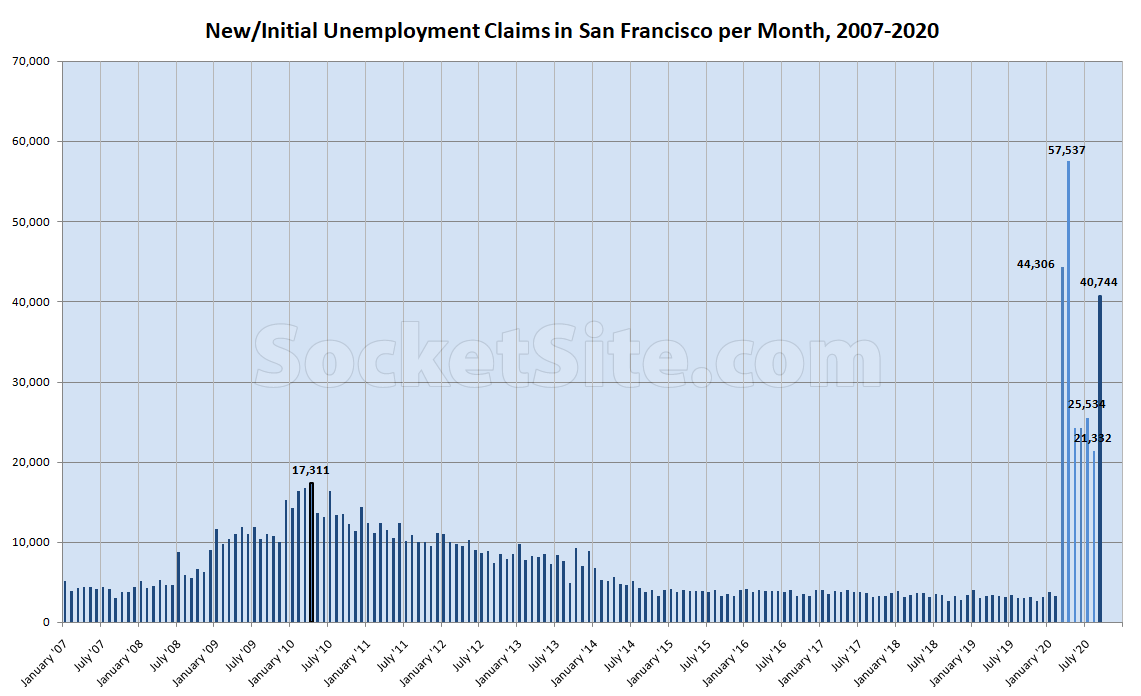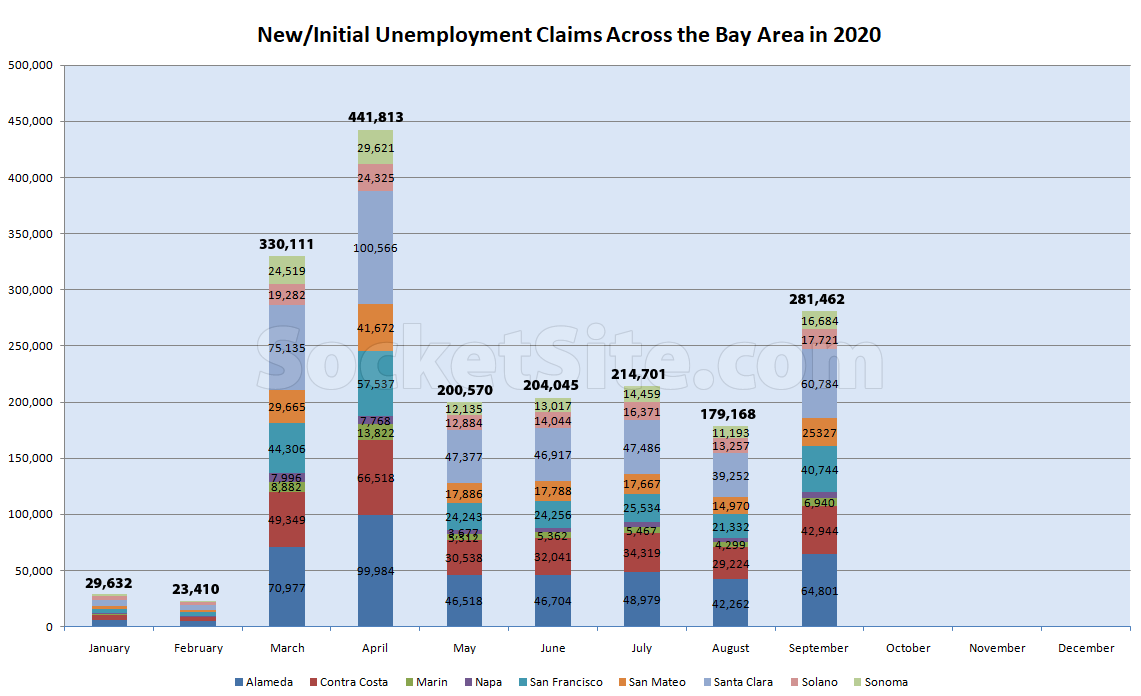As we noted last month, the rebound in Bay Area employment has sputtered. And in fact, the number of new unemployment claims filed across the Bay Area, which had been on the decline since peaking at 441,813 in April, spiked anew to 281,462 in September, which was up 57 percent from 179,168 in August.
In San Francisco, 40,744 residents filed a new/initial unemployment claim in September, a 91 percent jump from 21,332 in August, 135 percent more than at the peak of the Great Recession, and only 8 percent fewer than in March.


Welcome to the greater depression, that “recovery” is years off.
Even worse the March/April numbers were part of California’s fraudulent claims, these ones are much more accurate, get ready to see more new highs as benefits expire. Too bad but SF deserves everything coming it’s way. Good thing Twitter got those tax breaks, that sure paid off.
SF and Napa (I imputed it, the number isn’t shown on the graph) have the second worse resurgence @ 71% of peak totals, just behind Solano @73%; SC is only @ 50%. All of these supporting the idea that areas dependent on the ‘hospitality sector’ continue to be most impacted, whereas tech/WFH areas are the least. (And of course Napa has its own issues with conflagration).
But it’s all really good news, ‘cuz the people are still here to file, right? They haven’t fled. 🙂
Don’t worry, they’ll flee as soon as evictions are legal again.
Except Napa was the one county that peaked in March. As such, its ‘September resurgence’ was actually 69 percent of peak, behind Solano (73 percent) and San Francisco (71 percent).
And the ‘resurgence’ in Santa Clara County was actually 60 percent of peak, and 61 percent in San Mateo, with Alameda and Contra Costa at 65 percent, Sonoma at 56 percent and Marin at 50 percent (not SC).
Correct…I was thinking the placement on the chart (Bottom to top) matched the geography (S to N), and it seems to largely do so….Silicon Valley excepted.
That’s the thing – areas like SF where a lot of people can WFH clobbers the service industry, because those workers used to spend big in bustling downtowns. Some of that spending has shifted closer to home or online. Hence the high service unemployment we’re seeing there and LA, etc.
And some of it just disappears altogether: when you make yourself a PBJ @ home, that’s one less tilapia+quinoa burrito that’s not being made by someone else….and sold @400% markup.
and making sandwiches at home is one of the reasons WFH won’t last.
I think there’s much to what you say – all the same I wouldn’t be shorting Proctor-Silex stock right now – but by my handy-dandy metric for downtowny health (BART ridership) isn’t looking too good right now: currently @ 13%, going nowhere fast, and not looking to get well for a loooooooong time
During WFH I’ve been captivated watching re-run clips of Kitchen Nightmares on youtube and I can tell you that Gordon Ramsay has completely and permanently ended my interest in eating a mom-and-pop restaurants while at the same time I’ve been increasing my skill preparing food for my own consumption in my own kitchen.
Now, I would much rather eat a PB&J that I made myself and I know what went into it than trust some small business owner who is frantically trying to make inflated S.F. rents by cutting corners on food that he or she is selling and that’s before I even consider the 400% markup on the fancy burrito.
As of about three weeks ago, you can actually buy those packets of yeast in grocery stores without looking too hard. I’ve now started making my own focaccia for sandwiches (not PB&J).
Eating most meals at restaurants is a learned helplessness behavior, and some people, perhaps a minority, will learn that it’s capitalist conditioning working on them and there is no good reason for a sizeable portion of S.F.’s lower-end restaurants to exist (unless of course you’re a commercial landlord raking –well, were raking, prior to Feb of this year– in rents on restaurant space).
So of course people in that business (leasing restaurant space, pocketing rents and laughing all the way up the back nine) are going to go around saying that WFH won’t last. It’s in their pecuniary Interest to have other people believe that.
People can always file remotely. Maintaining a PO box or having a relative ply mail is cheaper than spending thousands on rent and waiting for that unemployment check!
Your benefits are based on your work history, so I don’t see any advantage to filing other than where you live.
If you mean filing from Utah or Georgia, or wherever, I believe THAT would constitute fraud.
How about Imperial County, CA or Modoc County, CA? There is egregious fraud and then there are exceptional circumstances. Clearly, pandemic is an exceptional circumstance.
Maybe we’re still in the first inning after all.
top of 4th inning of pandemic.
bottom of the 1st inning of economic fallout
I want to think you’re right on the pandemic. But I’m getting less optimistic. Vaccines are very hard to make, treatment is improving, which is good, but then there are the long haulers, and no one knows the long term effects.
The spike protein on this particularly virus is not complicated. Structurally this is a simple virus and a vaccine should be straightforward. The fact that the Regeneron mAb worked so well lends further credence to a vaccine being successful. There are 3-4 different approaches and 6 reasonable candidates in phase 3. I think at least 2 will work.
But don’t expect mass vaccination until Q2/summer, so the 1st half of 2021 will suck. And we have to deal with the idiots who don’t get vaccinated so Covid is not going away, but we should have it under control by June.
That would be a nice timeline, but even if it’s proven to work, which will still take some time, I’m still skeptical of manufacturing several billion doses by then.
I agree though that first half of 2021 will suck hard. The anti-science idiots are on the rise.
Even if “a vaccine should be straightforward” because “the spike protein on this particular virus is not complicated”, that does not mean that the virus won’t mutate. If it does mutate, and there is significant evidence that it has and will, the pandemic will simply restart.
And just wait with Thanksgiving Christmas and the holidays coming.
Lurking in the background: Climate Change. It was 82 this week inland. In November. And many elements are nearing the tipping point.
Of course, that will make fleeing to Arizona or Texas even more untenable, but…
Do you find 82 degrees in early November particularly odd? I don’t. My first take when I read that was to think that that’s normal.
The Bay Area is relatively protected from climate change.
The question is where all the people who are south or inland from here are going to go.
Exactly. California is getting dryer and hotter and fire season is getting longer and longer. The East Bay hills and exurbs will be burning, not to mention all those dream homes in the North Bay.
So actually “exactly…NOT” (at least as far as being “relatively protected”):
– In addition to the fire danger from increasing droughts and higher temperature, there’s the problem of erratic water supply from them, and some areas (Marin) are still dependent on local supplies;
– We are, of course, at sea level, so we’re quite at risk from changes in that.
So maybe not as ‘at risk’ as Miami or Phoenix, but compared to Spokane or Chicago or…most of the country we’re WORSE off.
SFRealist did not actually read what I wrote.
You don’t have to make stuff up, there are people who have actually put together nationwide maps of how screwed places are by climate change, so you can see how protected the Bay Area is relative to most of the country.
Challenge accepted. Oh wait…those are exactly the places I mentioned.
I’m not sure who you feel was “making stuff up”, but I would think the idea [ that an area that has substantial areas near sea-level – Mission Bay, Alameda, Foster City…indeed an area that has the word “Bay” in it – is going to have issues with changes in that level that a city like Spokane doesn’t] is so self-evident it doesn’t really warrant discussion.
As for increased fire danger, that’s pretty well documented too. It’s not going to affect Pacific Heights much, and if that’s what you meant I agree…but that’s not what you wrote.
We’re not universally worse off , of course: our lower summer temps make higher ones less onerous, but that’s only one small part of the problem(s).
You get zero points for guessing that cities that are almost in Canada will do better with global warming.
Real migrations are coming. I think ProPublica did the work and it was a simplified GIS analysis not a bottom-feeding “ten shocking cities that…” listicle.
I must say that you are very aggressive considering how little research you have done on the subject and I won’t be feeding you further.
Feed me “places…screwed by climate change” and you get infotainment; mention ‘Probublica’ and you’ll get a nifty set of color coding that readily crashes a computer (hence I won’t link it here).
Unfortunately said nifty colors don’t seem to support your narrative any more – or less – than mine: overall the Bay Counties seem to get a 5 (of 10) on overall GDP loss (which is – arguably – the most important single measure); but then half the country gets that measure…or better. San Mateo does poorly – 7 – on ‘Sea Level Rise’…. Imagine that!
Now back to the post: not Potential Perils of 2040-60 but the Ongoing Perils of 2020.
I did read what we wrote. The Bay Area as a whole is relatively well protected. I don’t count the East Bay exurbs as the Bay Area.
That being said, it will be far worse in Arizona, Texas, or Florida then it is here. And if you don’t think that Spokane is at increased fire risk……
“I don’t count the East Bay exurbs as the Bay Area.”
Noted – and discounted – accordingly.
And of course I didn’t say Spokane wasn’t at greater fire risk; I said it was at lesser risk for sea-level rise. If you disagree, with that …
I’m not sure what your point is. Spokane is lovely, but small. It’s also relatively dry and will only get drier.
Sea level rise is a much lesser risk here than in Florida, Louisiana, Houston, etc. It’s also is a less immediate problem. It will be an issue in maybe 25-50 years. Phoenix and the southeast is getting hotter faster than sea level is rising. The western United States is going to be burning every summer. Choose your poison, but the Bay Area is better suited than most of the country.
Somewhat sooner, perhaps. But yes, I agree, it likely has little to do with the recovery in jobs from the current situation …unless the recovery is THAT slow (at which point wet feet will be a small concern).
With another record number of cases today, I fear the job recovery will be slow.
in the meantime, South San Francisco planning for lots of new jobs, including some from SF…